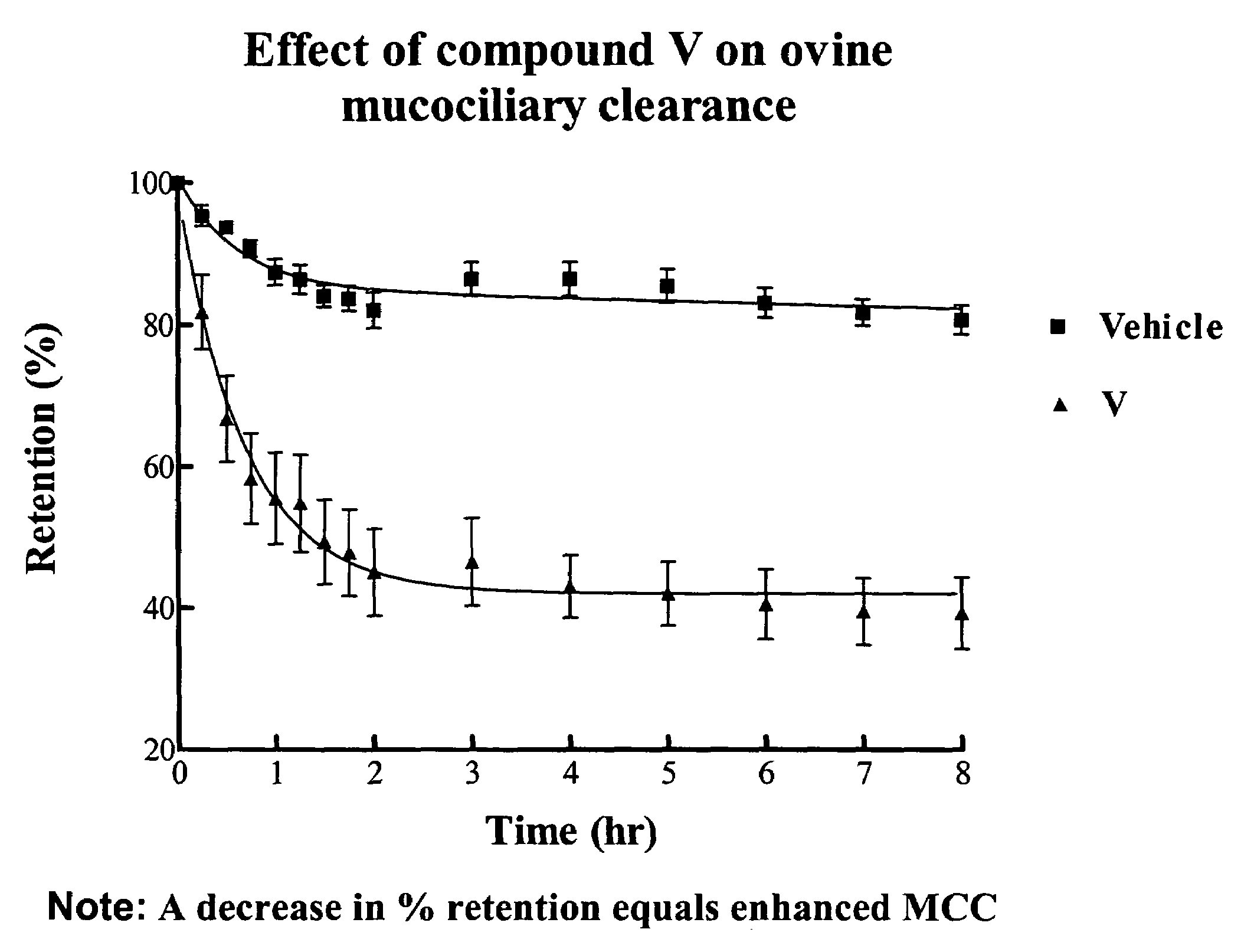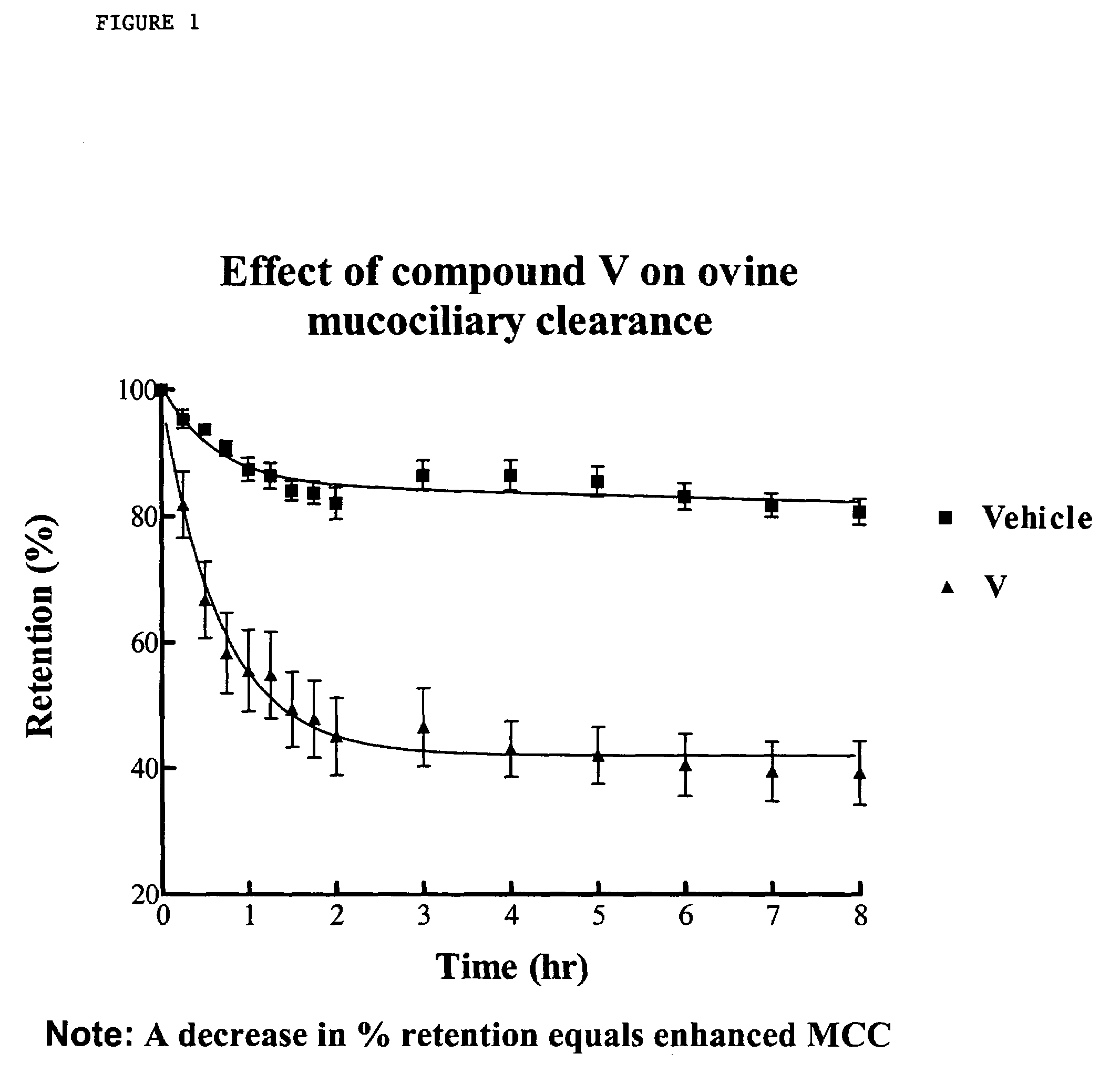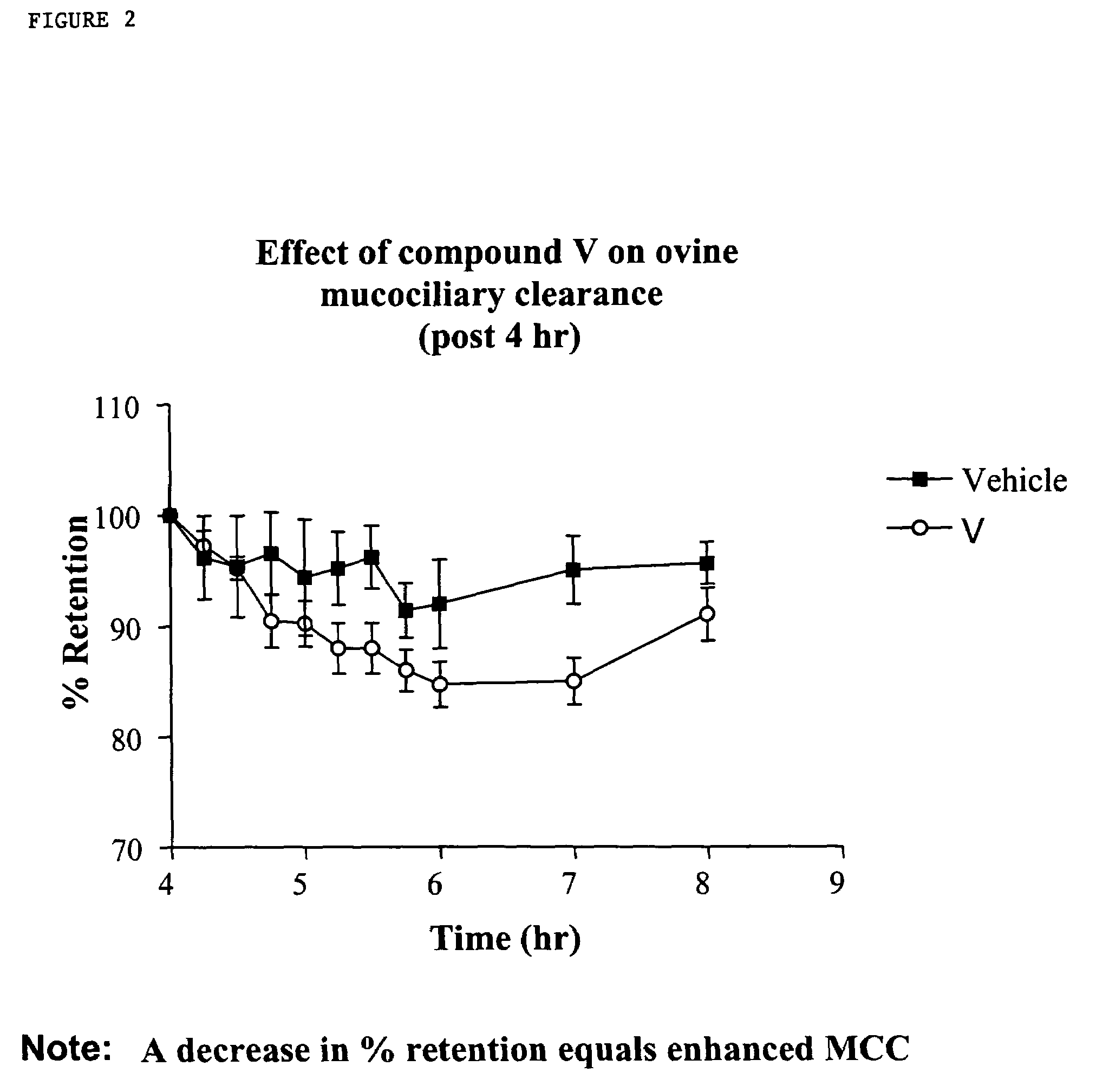Sodium channel blockers
a technology of sodium channel blocker and sulfate, which is applied in the direction of drug composition, biocide, extracellular fluid disorder, etc., can solve the problems of inability to clear mucus from airway surfaces, inability to clear mucus reflects an imbalance between the amount of liquid, and the inability to clear mucus, etc., to achieve less reversible, less reversible, and more potent
- Summary
- Abstract
- Description
- Claims
- Application Information
AI Technical Summary
Benefits of technology
Problems solved by technology
Method used
Image
Examples
example 1
4-(4-hydroxyphenyl)butylamidino-3,5-diamino-6-chloropyrazinecarboxamide hydrochloride (V)
[0225]The title compound was prepared as shown in Scheme 1 below. The 4-(4-hydroxyphenylbutyl)amine was prepared by routine organic transformations described in the following procedures. The coupling was done in accordance with the procedure described by Cragoe, E. J. Jr., Oltersdorf, O. W. Jr. and delSolms. S. J. (1981) U.S. Pat. No. 4,246,406, both incorporated herein by reference. The work up and purification were modified in accordance with the physical properties of V.
[0226]
4-Methylphenylsulfonic acid 4-(4-methoxyphenyl)butyl ester (I).
[0227]Pyridine (15 mL) was added dropwise to a cooled (0° C.) solution of 4-(4-methoxyphenyl)butanol (10.0 g, 0.055 mol) and p-toluenesulfonyl chloride (13.6 g, 0.072 mol) in dry chloroform (100 mL) under stirring. The reaction mixture was stirred overnight at room temperature. After this time, the reaction was quenched with 10% HCl (300 mL) and extracted wit...
example 2
4-(4-Hydroxyphenyl)butylamidino-3,5-diamino-6-chloropyrazinecarboxamide hydrochloride
[0232]
4-Methylphenylsulfonic acid 4-(4-methoxyphenyl)butyl ester (1).
[0233]Pyridine (15 mL) was added drop wise to a cooled (0° C.) solution of 4-(4-methoxyphenyl)butanol (10.0 g, 0.055 mol) and p-toluenesulfonyl chloride (13.6 g, 0.072 mol) in dry chloroform (100 mL) under stirring. The reaction mixture was stirred overnight at room temperature. After this time, the reaction was quenched with 10% HCl (300 mL) and extracted with chloroform. The organic fraction was washed with saturated NaHCO3, water and dried over magnesium sulfate. The solvent was removed under reduced pressure and the residue purified by flash chromatography (eluent:hexane / ethyl acetate 15:1) to provide 12.9 g (66%) of 1 as clear oil. 1H NMR (360 MHz, CDCl3) δ 1.61 (m, 4H), 2.44 (s, 3H), 2.52 (m, 2H), 3.78 (s, 3H), 4.05 (m, 2H), 6.77 (d, 2H), 7.05 (d, 2H), 7.34 (d, 2H), 7.78 (d, 2H).
4-(4-Methoxyphenyl)butylazide (2).
[0234]Sodium ...
example 3
3-(4-Hydroxyphenyl)propylamidino-3,5-diamino-6-chloropyrazinecarboxamide hydrochloride
[0238]
Methanesulfonic acid 3-(4-methoxyphenyl)propyl ester (11). Typical Procedure E.
[0239]Pyridine (15 mL) was added drop wise to a cooled (0° C.) solution of 4-(4-methoxyphenyl)propanol (10.0 g, 0.06 mol) and methanesulfonyl chloride (14.7 g, 0.078 mol) in dry THF (70 mL) under stirring. The reaction mixture was stirred overnight at room temperature. After this time, the solvent was removed under reduced pressure and the residue was quenched with 10% HCl (300 mL) and extracted with ethyl acetate. The organic fraction was washed with saturated NaHCO3, water and dried over sodium sulfate. The solvent was removed and the residual crude ester 11 was used in the next step without further purification. Compound 11 was obtained as a yellow oil (8.8 g, 60%). 1H NMR (300 MHz, CDCl3) δ 2.08 (m, 2H), 2.60 (m, 2H), 2.98 (m, 2H) 3.98 (s, 3H), 3.66 (s, 3H), 6.85 (d, 2H), 7.03 (d, 2H).
3-(4-Methoxyphenyl)propyla...
PUM
| Property | Measurement | Unit |
|---|---|---|
| size | aaaaa | aaaaa |
| size | aaaaa | aaaaa |
| size | aaaaa | aaaaa |
Abstract
Description
Claims
Application Information
 Login to View More
Login to View More - R&D
- Intellectual Property
- Life Sciences
- Materials
- Tech Scout
- Unparalleled Data Quality
- Higher Quality Content
- 60% Fewer Hallucinations
Browse by: Latest US Patents, China's latest patents, Technical Efficacy Thesaurus, Application Domain, Technology Topic, Popular Technical Reports.
© 2025 PatSnap. All rights reserved.Legal|Privacy policy|Modern Slavery Act Transparency Statement|Sitemap|About US| Contact US: help@patsnap.com



